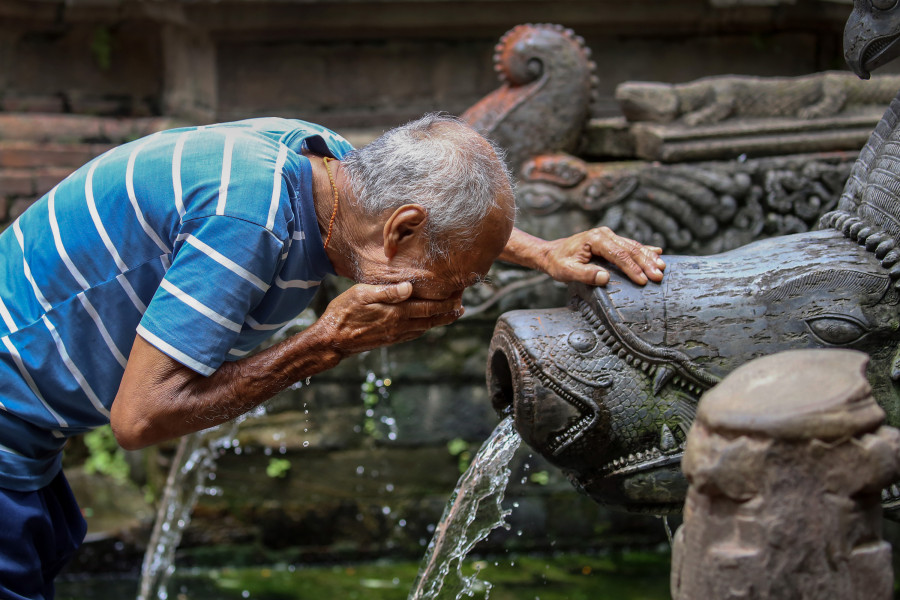Columns
Preserving the Valley’s water heritage
Traditional water infrastructures are helpful in extreme climate conditions and other disasters.
Ananda Manandhar
Water scarcity, frequent urban flash floods and groundwater depletion exacerbated by deep tedious practices are the evidence of poor urban water management in Kathmandu Valley. Unfortunately, the Hiti Pranali (traditional water systems), which could have been a valuable water management asset, suffer from negligence. Traditional canals (Kulo), ponds (Pukhu), wells (Tu), stone spouts (Hiti), spring wells (Kuwa) and water tanks (Jahru) are present throughout the valley, but their potential has not been recognised in the water management sector.
The disregard of these sources is in contrast with how relevant traditional water systems are in today’s urban context. For instance, the local community of Ikhachhen, Patan, manages water from the Alko Hiti that serves around 250 households via pipe systems. Similarly, the people of Nagbahal, Patan, have integrated pipe connections to traditional wells to meet their water needs. Locals of Thimi have attested to the increased water level in wells after the revitalisation of Nigu Pukhu (two ponds). These examples illustrate that traditional water systems perform very well locally, either as independent water systems or as a supplement to the conventional, centralised system.
Scholars have also highlighted the importance of water heritage to urban citizens. Traditional ponds, wells and spouts partially mitigate the issue of inaccessible and inequitable water distribution. Water from conventional sources is free of cost and is readily accessible to everyone. In his book Hiti Pranali, water heritage expert Padma Sundar Joshi vouches for the benefits of water heritage. For example, ponds help groundwater conservation and facilitate stormwater storage. In addition to such social and environmental significance, water heritage contributes to the city’s water management in many ways.
The water heritage of Kathmandu Valley is environment friendly. Stone spouts depend on local aquifers and use gravity flow for water transportation. Canals are also based on gravitational flow of water. The energy required for their operation is significantly less than other contemporary systems. Using water heritage also reduces pressure on the centralised water supply and the water source it draws from.
What’s more, traditional water systems are cost-effective. They are low-technology infrastructures based on indigenous hydrology knowledge and have been functioning for hundreds of years. They do not require complex infrastructures or significant investments for their operation. The restoration of degenerated canals, ponds and spouts might need some financial resources, but once revitalised, they can help provide a sustainable water supply in the long run.
The use of water heritage promotes the efficient use of diverse sources and quality of water—the main characteristic of sustainable water management practices. Our current practice of using high-quality treated water for all purposes is wasteful. While water from traditional canals, ponds, spouts, and wells might not be potable now, they still offer free water for functions such as washing, cleaning streets, urban greening and irrigating fields.
Traditional water infrastructures are also helpful in extreme climate conditions and other disasters. In case of decreased precipitation, aquifers and groundwater resources are maintained since canals and ponds continuously feed the sources. During excessive rainfall, ponds act as buffers, retain excess water and prevent flooding and soil erosion. Also, when staying at home is not an option during earthquakes, people can access water in public spaces via water heritage structures. Ponds and wells are proven resources for firefighting.
Furthermore, traditional water structures can be an effective alternative to conventional piped water systems. This is particularly essential for countries like Nepal, where disruption in centralised water supply is a common scenario. The Melamchi water supply system, which is expected to solve the water needs of Kathmandu Valley, is often halted due to unfavourable river conditions and technical issues. If we were to depend entirely on the Melamchi supply, any sudden interruption to it would be catastrophic for the urban centre. Locally based, decentralised traditional water systems help diversify water sources and enhance the community's resilience against crises.
To better tap the benefits of these highly valuable traditional water infrastructures, we must change the mindset that the large-scale centralised water system is the only means of fulfilling water services. Large-scale extractive infrastructures are unsustainable, especially for countries with weak institutional capacity. Localised sources like wells and spouts can also perform water functions to a significant extent.
Further, preventing the pollution of traditional water sources will lead to their greater use. The provision of wastewater management systems, solid waste management plans and monitoring of household septic tanks will stop waste discharge into traditional water sources.
Finally, authorities such as Kathmandu Upatyaka Khanepani Limited and municipalities should acknowledge water heritage as water infrastructures. Lacking as it is, current water heritage conservation is focused on heritage value rather than water utility. This approach ignores the overall system and concentrates only on visible elements.
The fact that traditional water sources can be utilised for urban water management has been proven by contemporary examples, such as the aqueducts in Rome supplying public water fountains and irrigating green parks. Hence, we should integrate water heritage into urban water management frameworks. One such way could be through establishing community-level institutions under municipalities that can manage traditional water infrastructures.
Beyond the preservation context, water heritage knowledge can also be applied to new urban development, such as making ponds in the traditional method for preventing flash floods and promoting urban greenery. Although not a panacea to Kathmandu’s water problems, traditional water infrastructures can contribute to sustainable urban water management.




 10.12°C Kathmandu
10.12°C Kathmandu













%20(1).jpg&w=300&height=200)

